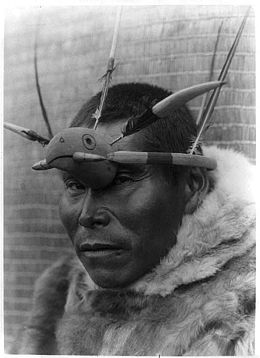Nunivak Island

Maskette – Nunivak
|
|
|
Nunivak Island (Alaska)
|
|
| Geography | |
|---|---|
| Location | Bering Sea |
| Coordinates | 60°05′42″N 166°12′40″W / 60.09500°N 166.21111°W |
| Area | 1,631.97 sq mi (4,226.8 km2) |
| Length | 77 km (47.8 mi) |
| Width | 106 km (65.9 mi) |
| Highest elevation | 1,675 ft (510.5 m) |
| Highest point | Roberts Mountain |
| Administration | |
|
United States
|
|
| State | Alaska |
| Census Area | Bethel Census Area |
| Largest settlement | Mekoryuk (pop. Under 100) |
| Demographics | |
| Population | 210 (2000) |
| Pop. density | 0.05 /km2 (0.13 /sq mi) |
| Ethnic groups | Cup'it Eskimo |
Nunivak Island (Nunivaaq in Central Alaskan Yup'ik, Nuniwar in Nunivak Cup'ig), the second largest island in the Bering Sea, is a permafrost-covered volcanic island lying about 30 miles (48 km) offshore from the delta of the Yukon and Kuskokwim rivers in the state of Alaska, at about 60° North latitude. Nunivak Island is 1,631.97 sq mi (4,226.78 km², or 1.044 million acres) in area, 76.2 kilometers (47.3 mi) long and 106 kilometers (66 mi) wide, making it the eighth largest island in the United States. It has a population of 210 persons as of the 2000 census. The island's entire population lived in the north coast city of Mekoryuk.
Nunivak has only one permanent settlement, Mekoryuk, on the north shore, with about 200 residents. In the 1880 United States Census, Ivan Petrof recorded 702 residents in nine villages on the island. An epidemic in 1900 decimated the population of the island. Emigration keeps the population small. Of the noted persons who have visited Nunivak are: photographer Edward S. Curtis, Anne Makepeace, anthropologist Margaret Lantis, and the artist Muriel Hannah.
Nearly all the permanent residents of Nunivak are Cup'it Eskimo, whose traditional language is a dialect of Central Alaskan Yup'ik known as Cup'ig or Nunivak Cup'ig. Cup'ig is a first language for many older islanders, and is enjoying a dedicated revival among younger islanders as well, although nearly all Nuniwarmiut (Nunivak people) speak English. The people of Nunivak Island still depend to a large degree on subsistence hunting, and also commercial fishing and industrial work on the mainland.
...
Wikipedia

